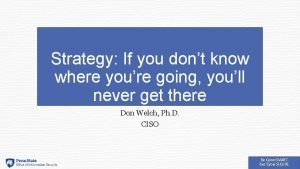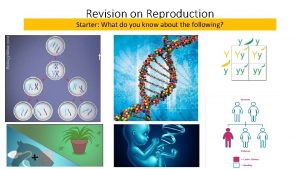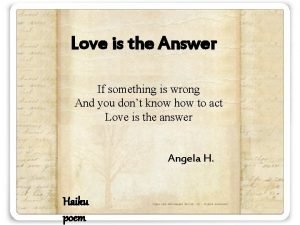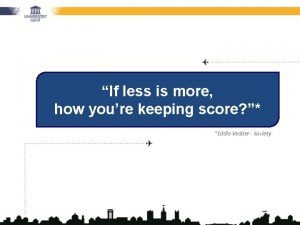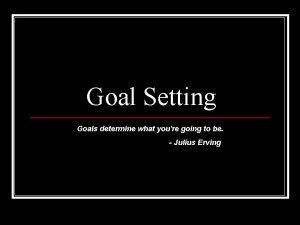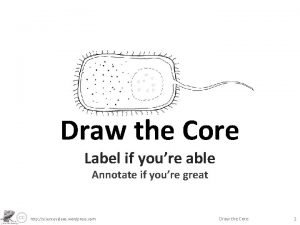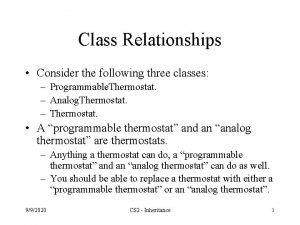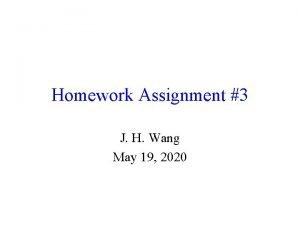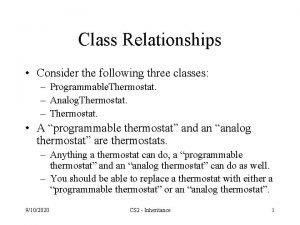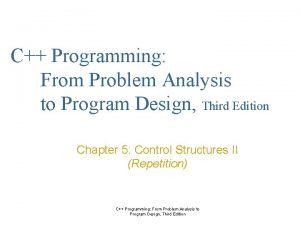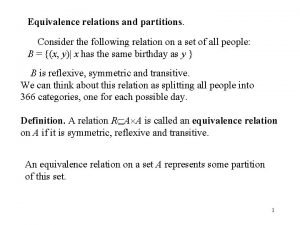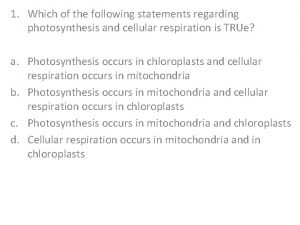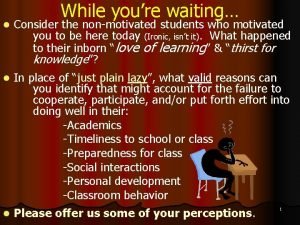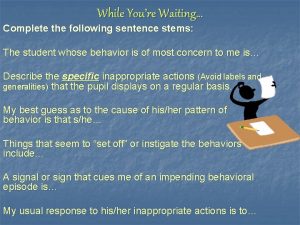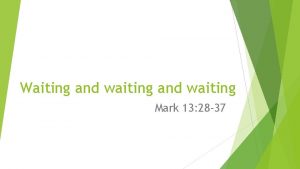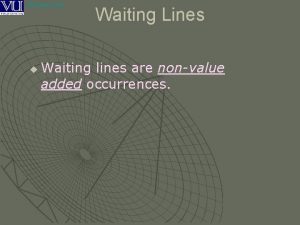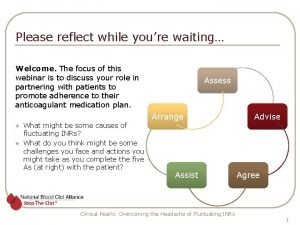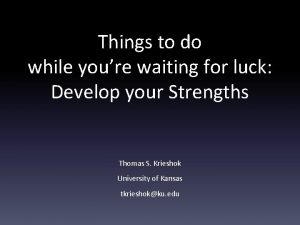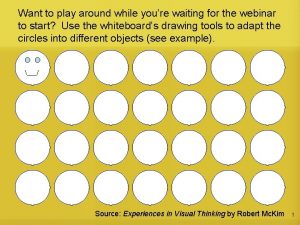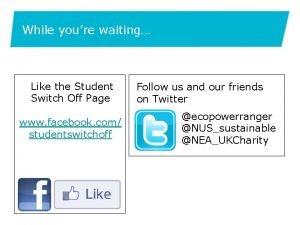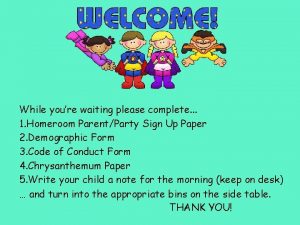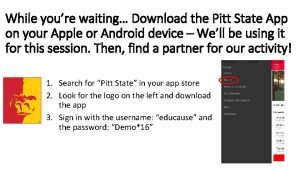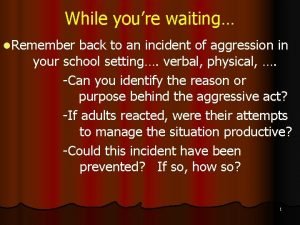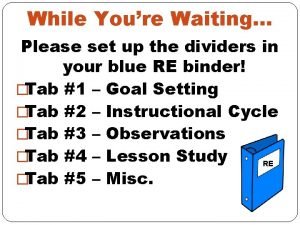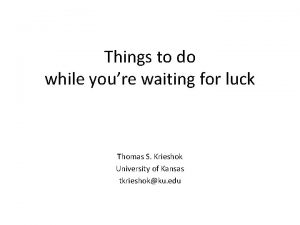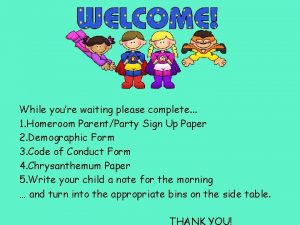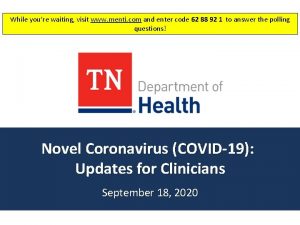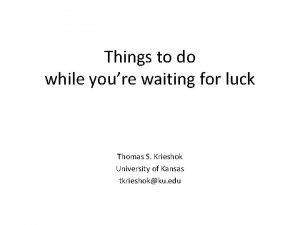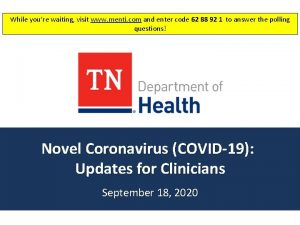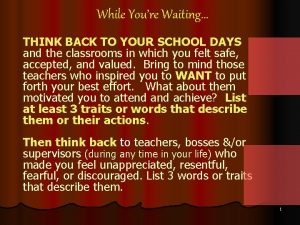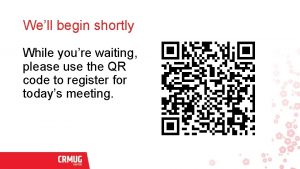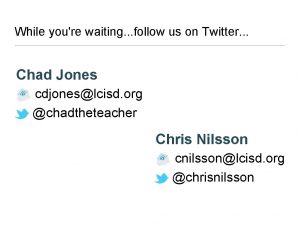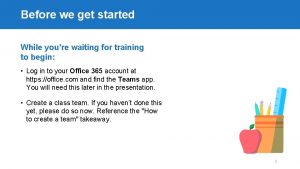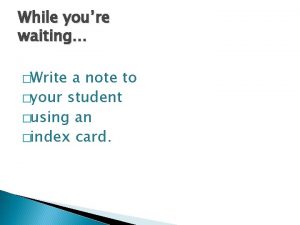While Youre Waiting Consider the following questions l
































































- Slides: 64

While You’re Waiting… Consider the following questions. l Why do some students lack the social skills needed to interact appropriately with others in the school setting? l Why do some kids, even after social skills instruction, fail to display desired behaviors? l When you think of a student in your class who lacks appropriate interaction behaviors, what skills in particular would you like to see him/her display? 1

“Socially Skilled”: The ability to respond to social activities or environments in a manner that produces, maintains, & enhances positive interpersonal effects. “Social Competence” OR “Social-Emotional Health” One’s overall social capability… the composite or multitude of desires & abilities that result in being “socially skilled”. So… what makes you so socially able? -Motivated to learn appropriate actions -Perceive social situations accurately -Able to identify the skills to use -Able to adequately perform the necessary skills -Sensitive to social feedback -Can tweak behaviors to fit situational requirements -Willing & able to emulate behaviors of others -Able to generalize to appropriate situations. 2

“Social Skills Training”: The teaching of appropriate interaction skills. – Direct instruction via planned lessons & spontaneous training in a “teachable moment”. – Indirect via prompting, modeling, “descriptive praise”, & “ripple effect”. Objective of SST: To help students develop the ability to relate well to others who share an activity and/or setting. 3

Fitting In How comfortable would you feel at: – – Streetcorner gathering Black barbershop Traditional large-family Chinese New Year meal Knighthood induction ceremony Cultural informants: What is needed for success in each of the above settings/events? Might some of us become more socially skilled than others in the above situations. Why? Might some of your students lack social skills for the school setting? – Why? . 4

So… which groups PDD: Aspergers & Autism of kids struggle the most with social challenges? Mentally Retarded BD A major diagnostic criteria for these disabilities The defining characteristic of BD – 3 X more likely to be socially rejected than gen. ed. kids – 2 X “ “ “ “ LD & MR kids Low income (“disorganized” segment… labeled or not) One’s social competence affects later life: – – – Job security Love & social relationships Interactions with legal authorities. 5

The Usual Please Anyone here teach social skills? If so: – – How so? Which curriculum? With whom? How often? If not: Why not? 6

SESSION AGENDA Overview Different types of social skills Why don’t our kids have them? Why don’t kids show them after they’ve been taught? Procedures for teaching S. S. to large & small groups Cultural issues Without a net: Teaching S. S. without $1000 curricula 7

Social Skills Training ^ Different Realms 1. Survival: Form the basic foundation for acquisition of more advanced skills & those in other realms such as: 1. Social interaction 2. Appropriate classroom behavior, work habits, & academic survival skills. (see below) 2. Interpersonal: Enhance chances of successful social interaction with persons of all ages & relationships. 3. Problem solving: Thinking strategies to prevent social problems or escape social discomfort. 4. Conflict resolution: Dealing with highly emotional situations, & resolving existing intrapersonal & interpersonal conflicts. 5. Others are often listed, like “Interpersonal perspective taking”, “Feelings identification”, “Communication skills”, etc. However, we’ll address the first four. 8

1. Survival Skills ^ What are the basic social skills? When in someone’s presence, … – – Acknowledge the other person Listen attentively & respond appropriately Conduct an accurate on-going self-evaluation of behavior Self reinforce for success What are the basic appropriate classroom behavior, work habits, & academic survival skills? Able & willing to… – – Comply with directions Maintain attention to task Seek assistance, attention & answers appropriately Accept & learn from consequences related to actions. 9

Which skills would you work on developing in Gayle? Video: The Friday spelling test. 10

2. Interpersonal Skills ^ To enhance the chances of social success & building of friendships, one must know how to…? Share Ask for permission Join an activity Contribute to discussions Answer questions Interrupt a busy person or conversation Wait for one’s turn or authority figure’s attention Begin/End a conversation Give/Accept compliments. 11

Which skills would you work on? (and with whom? ) Video: Shelly & lunchtime in the classroom. 12

3. Conflict resolution (intra & interpersonal) ^ Includes social skills for dealing with life’s frustrations & threats. They include being able to deal with… Being left out Negative peer pressure. Others? Teasing & taunting Accusations Anger directed at you by others The urge or pressure to fight Losing Making mistakes (publicly & privately) Fear Anger. 13

Which skills would you work on? (and with whom? ) Video: Craig during “down time” while waiting to be called to the assembly. 14

Problem Solving & Conflict Resolution ^ When one is involved in or facing a “problematic situation”, one needs to be able to…? Ask for help Apologize Negotiate. Understand & consider the feelings of others Understand & manage one’s own feelings Decide what to do & Make good choices Go with “Plan B” Respond to failure appropriately (accept it & learn from the experience) Accept consequences (and learn from the experience) Act assertively (not passive or aggressive) Use “I (us & we) messages”. Click for 3 parts of I message 15 15

CLICKERS: Which is the properly phrased “I message”? (Eye brows through my lesson plan before each class) 1. “I get upset when you treat others badly. ” 2. “I need for all of my students to be sitting criss-cross applesauce. ” 3. “I’m unable to teach when you’re so noisy. ” 4. “I’m disappointed to see that you’re out of your seat again. ” 5. All of the above (numbered) statements are properly phrased “I messages”. 16

“Use your garbage mouth again & you’re headed to the office. ” Select a negative “YOU Statement”. Imagine the “With your attitude, you’re gonna end up dead or on welfare. ” situation in which it was said. Rephrase it. (Self or partners) “You’ve got more excuses than any 12 people I know. You know, it’s not that you’re stupid. You’re just lazy. ” “You’re more trouble than you’re worth. ” “Why do you always yell out answers? Can’t you raise your hand? ” “Why are you out of your seat again? Are you hyperactive or rude? ” “If you’re not writing, you’re not earning points & can’t go. ” “Be careful Atlas! You’re going to drop it. ” BETTER YET: Recollect a “negative you message” heard (or said) recently. Rephrase it. * Feel free to disapprove of the BEHAVIOR, but NOT the student’s CHARACTER. (“Symptom Estrangement” or “Descriptive Criticism”). 17

Why Don’t Kids Have Social Skills? (before instruction) Never learned “appropriate behavior” – Misread social cues given off by others (Neurological? ) Don’t notice boredom or rejection by others View social forays of others as being threatening – Lack of supervision & training by elders – An alternative value & response system was taught Know (cognitively) what they should do, but don’t have: – Practice – Self-management due to: Being overwhelmed by emotions Misinterpretation of situational cues. 18

Manners & Boundaries: Civility, “Appropriate Behavior” & Re-channeling of Negative Energies Includes: 1. Knowing oneself & one’s emotions 2. Sizing up a situation quickly & responding within an acceptable conversational or interactional time frame 3. Proficient reading of the signals of others facial expressions & body language voice (volume, intonation) contextual cues 4. Having a practiced, easily accessed set of verbal skills (vocabulary, intonation) physical actions (hand extension, eye contact, smile). 19

Why Don’t Kids Have Social Skills? (after instruction) Don’t view skills as being useful in their lives. New actions don’t bring equal or better benefits. Display of new behavior is awkwardly performed. Student is unsuccessful. Views initial failure of new strategies as harbinger of future failure. Know what to do, but past interactions finds them objectionable to others. Due to the interpersonal history, they are quickly rejected or rarely given the chance to display their new skills. Under stress, resorts to old patterns of reaction. 20

The Flume: Class IV section (Bulls Bridge, Housatonic River, CT) 21

Types of Interpersonal Deficiencies ^ Skill deficit: Student cannot I. D. correct response for a social situation; actions are not in the student's behavior repertoire. Performance deficit: Correct social response can be identified by the student when questioned, but is displayed only during the role play situations. How do we respond to each? Skill deficits usually respond to direct instruction. Performance deficits usually require a guarantee that the new behavior will capture at least the same amount of benefits as the current behavioral response (& practice, practice to make it default choice). 22

Skill Deficit or Performance Deficit? 23

Teaching as it was… & should be Same ol’, Same ol’… As with the teaching of academics, begin with the prerequisite skills & then move on to the more advanced ones. Old School (Pre-NCLB & High stakes testing) Your social skills curriculum will be comprised of realistic, meaningful lessons that teach what is next in line for students to learn (with regard to classroom decorum & social needs). 24

Teaching Social Skills: Whole Class ^ Hold a class-wide discussion on the need for “people skills”. Have students contribute which skills create a more productive & pleasant learning environment. Select one social skill for the week. With kids, operationalize the behaviors via a “T-chart” Click to enlarge Click for example (attentive listening) Motivate as usual (posters, charts, point sheets, descriptive praise, etc. ) Ingrain the skill – Practice immediately (e. g. , Active listening & recognition of others practiced via round robin questioning session) – Give a daily mini-lesson everyday (or review periodically during left-over instructional time – Recognize youngsters for displays & approximations http: //home. att. net/~clnetwork/socialsk. htm for more detail on teaching the whole class 25

Teaching to Small Groups ^ 1. SELECT target students via assessment (Teach all the kids in a self-contained BD class). 2. Identify reinforcers that MOTIVATE. 3. Identify & define the TARGET behaviors. 4. TASK ANALYZE the target behavior. (if not already done by a packaged program) 5. TEACH. **We’ll do it all during a later activity** 26

Teaching social skills Video: Teaching social skills to a small group. NEA video of man with BD kids (3 rd or 4 th sequence) 27

Jerry-Riggs & Mac. Gyvers ^ Follow the suggested guidelines as best you can, modifying and improvising as necessary. Create groups of 1 -5 students with similar skill needs Choose easy-to-master skills 1 st Set up rules & procedures Collect data Teach to high-status kids 1 st Conduct sessions early in the morning Make the lessons fun Make lessons pertinent to their lives – How would you modify any of the following recommended skills to be more applicable to the lives of certain youngsters? (Next slide) 28

Take a minute to review these behaviors. Might some of the preferred actions ever be contraindicated with certain kids? From Kay Burke http: //www. phschool. com/eteach/professional_development/teaching_the_social_skills/essay. html 29

The American Way? If a student displays actions appropriate in his/her cultural group, but “incorrect” in mainstream North American culture (e. g. , lowering one's eyes when spoken to by an adult, physically fighting when mother's honor is insulted by another), is it appropriate to teach the "right ways" preferred in the schools (and found in social skills kits)? When, how & why would you do so? 30

When does differentiation of behaviors for different situations & settings trump “generalization” to other settings? “Streetcorner kids”. Why? Traditional cultural differences are present in the home. . . Differences in “correct behavior” such as? – Eye contact – Body spacing & touch conformities – Gender constrictions on body spacing & touch – Conversational pauses – How one responds to directions one does not wish to follow. 31

Be Like Me Often, packaged social skills programs promote social actions that, while esteemed by adults, would never be shown by any socially accepted kids in the mainstream (or student’s social group). In that case, becoming skilled in the new behavior does little to promote acceptance & positive interactions in most of the youngster’s lifespace. 32

The Typical Social Skills Lesson (desired outcome) Situation: Victor shows his yellow lunch card to the cashier. Joe, standing behind him with two other kids (from higher economic standing) taunts Victor saying “Hey Po’ Boy…Eating on my parents’ taxes again? How do you like the food I’m buying for you? ” Joe’s friends chuckle. Victor: “Please mind your own business. ” Joe: “Yeah, sure dirtball. You just go on over to your friends at the trailer trash table. ” Victor: “Joe, I don't appreciate the way you talk about me and my family. ” (Victor walks away. ) 33

Casey: Yo' Punk! W’sup with not passing the ball to Role. Open Playyo’#1 me under the net? eyes, sleepy. ” (tomy beblindfolded followedhook by discussion) Kip: Man, beats yo’ best. lay up. Casey: I ain’t seein’ all dat today. Yo’ “J” is broke. Situation: Two teams are playing basketball. Kip: Man, you be gettin’ used like soap by yo’ man the Time is running out &bethe score close when whole game. Don’t talking no is trash to me ‘til Kipget & Casey have a 2 -on-1 you yo’ game on, Bubbles. fast break. The sole goesbetter out to guard Kip who Casey: Yourdefender mama throws when she’s workin’ pullsthe uppole, to miss a long-distance jump shot from J man. beyond the 3 -point Caseyyo’ is mama furious Kip: Oh…playin’ house, circle. huh? N----er, because he was thebetter basket score more timeswide todayopen than under you. She at lay downs than yo’ lay. (Casey hoping forups the ball. moves aggressively toward Kip who says “Bring it on soapy. ”). 34

Role Play #2 (to be followed by discussion) Casey: Hey, Kip. I was open under the hoop. Pass the ball, man. (Respectful with suggestion. Disagreement is with the problem, not the person. ) Kip: Alright, man. I'll get you next time. I thought I could hit it or you’d get the rebound. (Has opportunity to respond with reason) Casey: Let's just get the ball back, Bro. (Focus on solution & keeping the bond) Outcome: They play hard. Kip gets a rebound and passes “the rock” down-court to Casey who scores on a break-away lay-up. 35

Micro-Cultures: Teaching “Tough” Kids^ Joke & laugh about the new behaviors in order to…? Address & defuse the issues up front (& again later) Switch to serious tone to talk about their importance. – Why would “resistant” kids want to use the new actions if they’re contra-indicated in their milieu? – What are the benefits outside of their present lifespace? Job interviews, disciplinary meetings, police stops, meeting new people outside of group, etc. We must also engage in “character education” in order to avoid…? creating better manipulators. 36

From Talk to Action… During the rest of today’s session, we’ll be putting this information into practice… Remembering that each lesson or experience should be processed & evaluated in 2 ways: – How well was the behavior displayed? (Social skills) – What has been learned from the experiences? (Cognitive skills) In other words…Students report on what they have learned from a role play or real-life attempt as well as their progress in displaying appropriate social skills via the 5 W & HA! example (click here). 37

1. Select Target Students ^ Student’s Self Assessment 1 st step - Students complete (by self or in conference) “Teaching Social Skills: Student Self-Report Form” (elem. ) OR “How Are My Social Skills Checklist” (adolescent) (Pages 1 - 4 in your packet) 2 nd step – Use the information for…? - understanding of the student - determining accuracy of self perceptions - conversation starters to attempt to motivate active participation from the student. ? Any thoughts on the questions asked of the students? If you’re enrolled in an online staff development course, you can find a checklist at: http: //www. 4 -h. uiuc. edu/opps/pyd_club/lp_careadult_socialskills. pdf 38

Teacher’s Assessment ^ 1 st step – Complete the “Social Competence Screening Form” (SCSF) (To identify students in most need) (Page 5 in packet) 2 nd step – Complete the “Social Skills Matching Form”, circling the numbers of the students (from the SCSF) who need instruction in each of the 23 skills listed (or others you identify). (Pages 6 -7 in packet) 3 rd step - Use info from the SSMF to form groups for each social skill unit. Your Task: Complete the teacher forms. – Take 10 minutes to do so. – Tom is available to explain & assist. If you’re enrolled in an online staff development course, you can find a checklist at: http: //www. centraliowachildcare. org/healthconsulting/schoolagescreentoolkg. pdf 39

2. Identify reinforcers that will motivate participation. ^ Move Clifford along the wall toward Emily Raffle tix Group or individual points toward event or privilege (1 -3 points for each 5 min. review of attention/participation) Progressively open or close window blinds Others that might work for your students? 40

3. Identify & define target behaviors. ^ Decide upon the most needed social behavior. Define the behavior so precisely that everyone agrees as to which actions are to be demonstrated. Instead of “Student will be polite. ”, identify the actions: – Students will say “Thank you. ” when someone does something nice for them or gives them something. – Students will say “Excuse me. ” when needing to interrupt conversations or concentration of others. – Rather than uttering a directive when seeking assistance, students will make a request that includes the word “Please”. 41

Precision Definitions: Brainstorm with me Asking permission: “Student verbally requests the privilege of engaging in an action. ” Staying out of fights: “Student walks away from verbal or physical aggression aimed at him/her. ” Showing Sports(wo)manship: “Student… – accepts referee’s call without comment. ” – abides by the rules & their intent. ” – congratulates an opponent at end of a contest. ” 42

Your task: (5 minutes) ^ Go to your completed “Social Skills Matching Form” By yourself or with your colleague(s) – Decide which social skill is most important to teach – Precisely define the behavior so that it is: specific to the setting and students of concern able to be identified as “displayed” or “not displayed” by anyone observing the youngster(s). Be ready to offer your definition to our group (if selected randomly by Dr. Mac from the roster). 43

4. Task analyze the target behavior ^ Delineate the simple behaviors that comprise the complex “behaviorally defined” action. They might be displayed either: – in sequential order – at the same time as other sub-behaviors Same time: “Listening” – Face up with eyes on speaker – Nose pointed toward speaker – Lips closed except for ‘positive sounds (explained) – Be able to paraphrase message & comment respectfully. 44

Sub-skills in Sequential Order: “Respecting the Opinion of Others” ^ Offer an empathy statement: – “I know that you feel that way, but…” – “I can see how you might think that way, however…” Give an assertive (not hostile) statement of feelings: (If applicable) – “this really gets my goat. ” – “it’s frustration to have my views distorted. ” Disagree on subject without attacking speaker: – “I view it differently, because…” – “The way I see it, the truth is that…” . 45

Another One in Sequential Order “Following directions” – Listen carefully to the direction – Restate the direction (out loud or to self) – If confused, ask for clarification – Attempt to accomplish the task – Ask for assistance if needed. 46

Your Task (5 minutes): Use T. A. to “Break Down” the complex, multi-step behavior ^ Task analyze the behavior that you selected as being the most needed. OR Select “Greeting others” – Familiar (family & friends) – Unfamiliar Adult Peer – Same gender – Other gender – Younger – Older OR Select a behavior from the “Social Skills Matching Form”. 47

5. TEACH ^ Plan out a unit for the teaching of the behavior. Do so as you would for a unit on academic material. Would anyone like to share a couple of ideas of some parts of lessons that would be in their unit? Examples of social skills units planned using today’s process can be found at: www. behavioradvisor. com/Social. Skills. html Essentially, the steps to follow when teaching social skills are… 48

Tell ‘em: Introduce & discuss What’s in your intro? – – ^ Observations on class behavior toward others Belief in ability to do better Overview of program Why & how program will benefit them. How will it benefit them? ? Show ‘em: Model the new behavior (perhaps with coteacher) (You. Tube “social skills training”). Watch ‘em: Role play Share with ‘em: Feedback Send ‘em forth: (perhaps placed in situations where can use skill) – Positive recognition for use (perhaps prompted at 1 st) – Homework assignments (5 W & HA sheets) – Surprise tests. Bring ‘em back: – Periodic review sessions – Role play troublesome situations – Set new goals Sequence #4 of NEA video (“connecting”) here. Male T with BD students. ? . 49

6. Follow-up ^ Monitor performance. Collect data for evaluation & decision- making purposes (Pages 12 -13 in your packet) Teach new social skills while periodically revisiting old ones. Work on “generalization” (while observing the cautions we mentioned). . . 50

Poof! ^ Biggest problem in social skills training is getting behaviors to: – endure longer than end of the training session, & – transfer to other settings. What factors would hinder generalization? – Lack of cues & prompts in new setting – Different cues being present (not practiced before) – Skills we taught are not promoted in new setting – Lack of opportunity to display the new behavior – Lack of reinforcement for display in new setting. 51

Transfer Training: How do we promote Generalization? ^ Practice throughout the day different settings under varied conditions Prompt & coach in naturally occurring situations Unannounced tests involving other staff & students Self-report forms (click) after each event, period, or day. Periodic meetings to access progress & success. 52

Published Curricula & More ^ (Goldstein & Mc. Ginnis) The Prepare Curriculum & Skillstreaming in early childhood the elementary school child the adolescent (Boys Town Press) Basic social skills for youth (Hill Walker) Walker Social Skills Curriculum – “Accepts” “Model Me Kids” Video Training Series (click to go to sample) Self-help books from: – Magination. Press. com – Free. Spirit. com (search for “social skills”) (Mc. Intyre) The Behavior Survival Guide for Kids (+ lesson plans) 53

Complete the T-Chart for “Positively Recognizing The Attempts of Others” ^ Back to Steps slide By Laura Candler at http: //home. att. net/~clnetwork/socialsk. htm 54

Operationalize the Behavior. Make it “observable & measurable” ^ Brainstormed with kids. Go to Blank From Kay Burke http: //www. phschool. com/e teach/professional_develo pment/teaching_the_social _skills/essay. html 55

Name: Pablo Date: February 24, 20 - - ^ Skill: (Home work) Greeting adults & kids you don’t know Steps to follow: 1. Look at the person’s eyes 2. Smile 3. Using a “happy to see you” voice, say “Hello. ” or “Good morning. ” 5. Extra: Compliment, Talk about weather, or Ask a question. Goal: Each time that I make a polite greeting, I will record the “ 5 Ws & HA!” Who did I say it to? What did I say? When & Where did I say it? Why did I greet them? How did they respond? Analysis? (How well did I perform the behavior? Does anything need changing? What did I learn? ) Return to the previous point 56

3 Parts of an “I message” When (describe what happened without using “you”) I feel (identify feelings) I would like (make a request) Show Intervention Central Video Return to the rest of slide show 57

Extra Time Criticizing a student’s performance… 58

C - Sandwiches: Emotional Health Food ^ “Eddie, you did a great job of remembering to put your backpack on your closet hook. Now your jacket has to be put away too. (Student says “Oh!”…and goes to the closet) I know we’re going to see your items on the hook from now on. ” Luis, I appreciate your help in keeping Rodney on task. However, prodding someone to finish so that you can copy his answers deprives you of true learning. From now on, I look forward to seeing you working hard on your own assignment inbetween the reminders to Rod. Pon 59

Finding the Pony in the Pile of Manure ~ “Jackson, I admire your generosity to friends. It’s a positive personal trait to want to provide them with the lunch that they forgot to bring. That said, extorting money from others on their behalf detracts from that act of friendship. It can bring you trouble and keep others from seeing your friendship efforts positively. However, let me reiterate: Your attempts to please friends is an admirable characteristic. So let’s discuss how to be both friendly and law-abiding. ” (Engage in Problem Solving) click 60

Clickers: Which one is the properly phrased “Criticism Sandwich”? 1. “You can be proud of remembering to capitalize the first word of each sentence, even if you forgot to use any punctuation. So what do we need to remember? Right. Don’t leave out those commas, periods, and question marks in the next draft. ” 2. “You’ve added many more adjectives, creating a more interesting piece. Now let’s focus on adding more adverbs in the last rewrite. You’re getting the hang of adding details, and I’m anxious to read a final draft with even more detail. ” 3. Both of the above items are examples of wellworded “criticism sandwiches”. Activ 61

This slide show was developed by: Tom Mc. Intyre Coordinator of the graduate program in behavior disorders Department of Special Education Hunter College New York, NY 1021 Thomas. mcintyre@hunter. cuny. edu www. Behavior. Advisor. com 62

To Do 4 Online Reproduce the participant packet (PDF form? ) for downloading with this Powerpoint show. 63

Click for flashdrive avi 64
 How to write email writing
How to write email writing What to do when youre angry
What to do when youre angry Good afternoon everyone
Good afternoon everyone Jesus youre my firm foundation
Jesus youre my firm foundation You're so random
You're so random Jesus is my master
Jesus is my master I dont know where youre going
I dont know where youre going What are the signs of an asexual person
What are the signs of an asexual person Love and hate poem
Love and hate poem How youre
How youre Review and revise your tentative goal statement
Review and revise your tentative goal statement Youre able
Youre able And the tree was happy
And the tree was happy Do loop adalah
Do loop adalah Consider the following three classes
Consider the following three classes Consider the following snapshot of a system
Consider the following snapshot of a system Consider the following three classes
Consider the following three classes Consider the following c program
Consider the following c program Consider the following c function void swap
Consider the following c function void swap Consider the following situations
Consider the following situations Consider the following relation
Consider the following relation Which of the following statements regarding the
Which of the following statements regarding the While the world watched chapter questions and answers
While the world watched chapter questions and answers Hình ảnh bộ gõ cơ thể búng tay
Hình ảnh bộ gõ cơ thể búng tay Lp html
Lp html Bổ thể
Bổ thể Tỉ lệ cơ thể trẻ em
Tỉ lệ cơ thể trẻ em Voi kéo gỗ như thế nào
Voi kéo gỗ như thế nào Chụp tư thế worms-breton
Chụp tư thế worms-breton Hát lên người ơi
Hát lên người ơi Môn thể thao bắt đầu bằng chữ đua
Môn thể thao bắt đầu bằng chữ đua Thế nào là hệ số cao nhất
Thế nào là hệ số cao nhất Các châu lục và đại dương trên thế giới
Các châu lục và đại dương trên thế giới Cong thức tính động năng
Cong thức tính động năng Trời xanh đây là của chúng ta thể thơ
Trời xanh đây là của chúng ta thể thơ Mật thư anh em như thể tay chân
Mật thư anh em như thể tay chân Phép trừ bù
Phép trừ bù Phản ứng thế ankan
Phản ứng thế ankan Các châu lục và đại dương trên thế giới
Các châu lục và đại dương trên thế giới Thơ thất ngôn tứ tuyệt đường luật
Thơ thất ngôn tứ tuyệt đường luật Quá trình desamine hóa có thể tạo ra
Quá trình desamine hóa có thể tạo ra Một số thể thơ truyền thống
Một số thể thơ truyền thống Cái miệng xinh xinh thế chỉ nói điều hay thôi
Cái miệng xinh xinh thế chỉ nói điều hay thôi Vẽ hình chiếu vuông góc của vật thể sau
Vẽ hình chiếu vuông góc của vật thể sau Nguyên nhân của sự mỏi cơ sinh 8
Nguyên nhân của sự mỏi cơ sinh 8 đặc điểm cơ thể của người tối cổ
đặc điểm cơ thể của người tối cổ Thứ tự các dấu thăng giáng ở hóa biểu
Thứ tự các dấu thăng giáng ở hóa biểu Vẽ hình chiếu đứng bằng cạnh của vật thể
Vẽ hình chiếu đứng bằng cạnh của vật thể Tia chieu sa te
Tia chieu sa te Thẻ vin
Thẻ vin đại từ thay thế
đại từ thay thế điện thế nghỉ
điện thế nghỉ Tư thế ngồi viết
Tư thế ngồi viết Diễn thế sinh thái là
Diễn thế sinh thái là Dạng đột biến một nhiễm là
Dạng đột biến một nhiễm là Số.nguyên tố
Số.nguyên tố Tư thế ngồi viết
Tư thế ngồi viết Lời thề hippocrates
Lời thề hippocrates Thiếu nhi thế giới liên hoan
Thiếu nhi thế giới liên hoan ưu thế lai là gì
ưu thế lai là gì Hổ sinh sản vào mùa nào
Hổ sinh sản vào mùa nào Khi nào hổ mẹ dạy hổ con săn mồi
Khi nào hổ mẹ dạy hổ con săn mồi Hệ hô hấp
Hệ hô hấp Từ ngữ thể hiện lòng nhân hậu
Từ ngữ thể hiện lòng nhân hậu Thế nào là mạng điện lắp đặt kiểu nổi
Thế nào là mạng điện lắp đặt kiểu nổi






